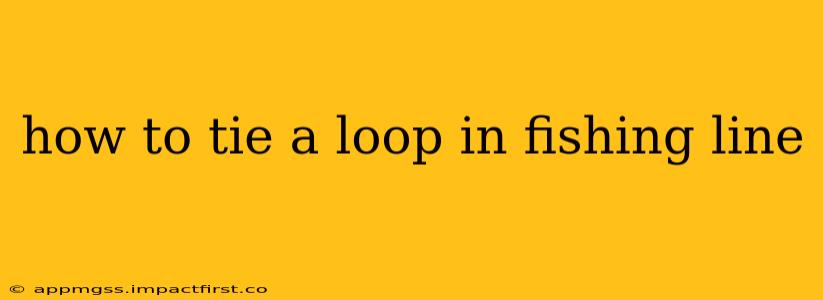Tying a reliable loop in your fishing line is a fundamental skill for any angler. Whether you're using a leader, connecting to a swivel, or attaching a lure with a loop connector, mastering this technique significantly improves your fishing experience. A secure loop ensures your line holds strong under pressure, preventing frustrating break-offs and lost catches. This guide will walk you through several popular and effective knot-tying methods, answering common questions anglers have about this crucial skill.
What are the Best Knots for Tying a Loop in Fishing Line?
Several knots excel at creating strong, reliable loops in fishing line. The choice often depends on the line type (monofilament, fluorocarbon, braided), line diameter, and the specific application. Here are some top contenders:
- Improved Clinch Knot: A classic and widely used knot, the Improved Clinch Knot is relatively easy to learn and incredibly strong. It's suitable for various line types and is a great all-around choice.
- Uni Knot: This knot is known for its superior strength and smooth action, particularly valuable with braided lines. It's a slightly more complex knot to master but well worth the effort.
- Blood Knot: Excellent for joining two lines of similar diameter, the Blood Knot can also be adapted to create a loop. It offers exceptional strength and is a favorite among experienced anglers.
- Loop Knot: A simple yet effective knot, specifically designed for creating a loop. Ideal for smaller lines and situations where speed is a priority.
How Do I Tie an Improved Clinch Knot Loop?
The Improved Clinch Knot is a versatile and reliable choice for creating a loop. Here's a step-by-step guide:
- Create the Loop: Leave a tag end of approximately 6-8 inches. Form a loop of the desired size with your fishing line.
- Pass the Tag End: Pass the tag end through the loop and wrap it around the standing line 5-7 times (more wraps for thicker lines).
- Tuck and Tighten: Tuck the tag end through the loop created by your first wrap, close to the hook.
- Moisten and Tighten: Moisten the knot with saliva or water and gently tighten the knot by pulling the standing line. Carefully trim the excess tag end.
How Do I Tie a Uni Knot Loop?
The Uni Knot is renowned for its strength and smoothness, especially useful with braided lines.
- Create the Loop: Make a loop of the desired size.
- Double the Tag End: Double the tag end of the line and pass it through the loop.
- Wrap the Tag End: Wrap the doubled tag end around the standing line 5-7 times (adjust based on line diameter).
- Pass Through the Loop: Pass the doubled tag end through the loop formed by the initial double-over step.
- Moisten and Tighten: Moisten the knot and carefully tighten by pulling on both the standing line and the tag end.
How Strong Are these Knots?
Knot strength depends on several factors, including line type, knot technique, and line condition. While an improperly tied knot will always be weaker, the knots discussed above generally retain a significant percentage of the line's breaking strength when tied correctly. Proper wetting and careful tightening are essential for maximum strength.
Which Knot Should I Use for Different Line Types?
- Monofilament: Improved Clinch Knot or Loop Knot work well.
- Fluorocarbon: Improved Clinch Knot or Uni Knot are good options.
- Braided: Uni Knot is generally preferred for its strength and smooth action.
What If My Knot Doesn't Feel Secure?
If a knot feels insecure, it likely wasn't tied correctly. It's better to untie and retie the knot than risk a broken line during a crucial moment. Practice tying the knots several times until you feel confident in their secureness. Watch instructional videos online; many detailed tutorials can help clarify any confusion.
How to Improve My Knot-Tying Skills?
Practice makes perfect. Set aside some time to repeatedly tie the knots with scrap line until you can do so quickly and confidently. Refer to clear diagrams and instructional videos for visual assistance. Consider using a knot-tying tool to assist, especially when dealing with thinner lines.
By mastering these loop knots, you'll significantly enhance your fishing success and enjoyment. Remember, practice and attention to detail are key to tying strong, reliable loops that hold up under pressure.
